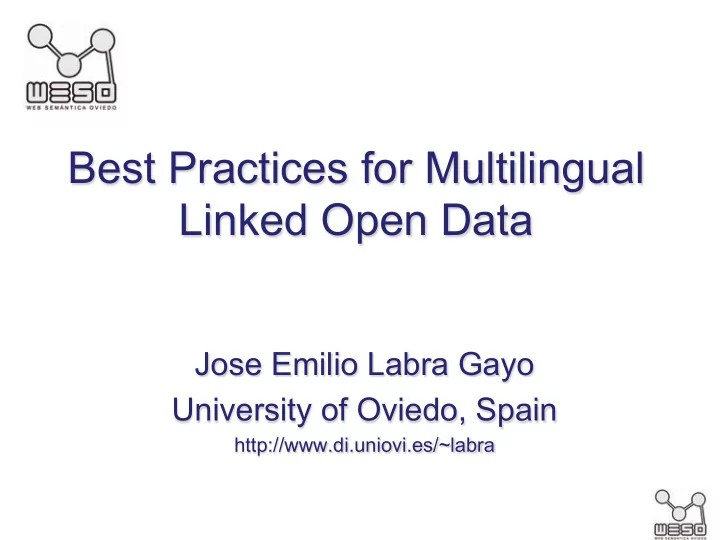

Best Practices for Multilingual Linked Open Data Jose Emilio Labra Gayo University of Oviedo, Spain http://www.di.uniovi.es/~labra
About me WESO Research Group ( Web Semantics Oviedo, since 2004 ) Several projects involving Multilingual LOD Example: EU Public procurement notices (MOLDEAS) Catalog of product schema clasifications (1842053 triples) �tt�r ¡ ¡t����t��p�g��� ¡��t�h�t ¡�h�hs��t����p�� Common Procurement vocabulary (803311 triples) �tt�r ¡ ¡t����t��p�g��� ¡��t�h�t ¡��:s3jjf� 23 EU languages Jose Emilio Labra Gayo, http://www.di.uniovi.es/~labra
Towards the web of data Web of documents Web of Data Unit of information: Web page (HTML) Unit of information: data (RDF) Human readable Machine readable Challenge: Multilingual pages Intrinsically Multilingual Jose Emilio Labra Gayo, http://www.di.uniovi.es/~labra
Example English Espanish =�t�������mn��n" =�t�������mn�hn" =���d" =���d" =�+"�p��8h����������= ¡�+" =�+"�a��������h���������p��= ¡�+" � � =�"�p����h��������hh����t�t��� =�"�p����h���t���at�������������� ���:��h�td�����:����o������= ¡�" ������:��h���������:����o��h��u�= ¡� " � � =�"�����r�<41s+341567= ¡�" =�"�����r�<41s+341567= ¡�" =�"�����r�<41s+341567= ¡�" =�"�����r�<41s+341567= ¡�" = ¡���d"� = ¡���d"� = ¡�t��"� = ¡�t��"� �tt�r ¡ ¡p���:�g�h ¡������#�p��� Intrinsically multilingual ����r����� t��r<41s+341567 Jose Emilio Labra Gayo, http://www.di.uniovi.es/~labra
Multilingual data Data that appears in a multilingual context It contains labels/comments Human-readable information Using different languages/conventions Jose Emilio Labra Gayo, http://www.di.uniovi.es/~labra
Example of Multilingual Data English Espanish =�t�������mn��n" =�t�������mn�hn" =���d" =���d" =�+"�p��8h����������= ¡�+" =�+"�a��������h���������p��= ¡�+" � � =�"�p����h��������hh����t�t��� =�"�p����h��������hh����t� =�"�p����h���t���at�������������� =�"�p����h ��t���at����� ���:��h�td�����:����o������= ¡�" ������:��h���������:����o��h��u�= ¡� " � � =�"�����r�<41s+341567= ¡�" =�"�����r�<41s+341567= ¡�" = ¡���d"� = ¡���d"� = ¡�t��"� = ¡�t��"� �tt�r ¡ ¡p���:�g�h ¡������#�p��� Web of Data �er��h�t��� �er��h�t��� Unit of information: data (RDF) Human + Machine readable n��t���at���ni�h n�����hh��ni�� New Challenge: Multilingual Jose Emilio Labra Gayo, http://www.di.uniovi.es/~labra
Linked Open Data Principles on how to publish data Increasing adoption Jose Emilio Labra Gayo, http://www.di.uniovi.es/~labra
Best practices for LOD Several proposals: Linked data book [Heath, Bizer, 2011] Linked data patterns [Dodds, Davis, 2012] Best Practices for Publishing Linked Data [Hyland et al] SemWeb Rules of thumb [R. Cyganiak] etc. . . In this talk Best practices affected by multilinguality Jose Emilio Labra Gayo, http://www.di.uniovi.es/~labra
Multilingual LOD practices 1. Design a good URI scheme 2. Model resources, not labels 3. Use human-readable info 4. Labels for all 5. Use Multilingual literals 6. Content negotiation 7. Literals without language 8. Multilingual vocabularies Jose Emilio Labra Gayo, http://www.di.uniovi.es/~labra
1. Design a good URI scheme Cool URIs Don't change Identify things If possible, use human-readable URIs �tt�r ¡ ¡�������g��� ¡��h�p��� ¡ Spain Jose Emilio Labra Gayo, http://www.di.uniovi.es/~labra
1. Design a good URI scheme Use IRIs? Most datasets use only URIs IRIs may be difficult to maintain Domain names, phising, … IRI support in current libraries Human-readability? �tt�r ¡ ¡�������g��� ¡��h�p��� ¡ Armenia �tt�r ¡ ¡�������g��� ¡��h�p��� ¡ Հայաստան հտտպ :// դբպեդիա . օրգ / րեսօուրսե / Հայաստան �� Jose Emilio Labra Gayo, http://www.di.uniovi.es/~labra
2. Model resources, not labels Define URIs only for resources Resources do not depend on a given language Assign labels to those resources Do not mint separate URIs for labels Jose Emilio Labra Gayo, http://www.di.uniovi.es/~labra
2. Model resources, not labels �r/�������� �tt�r ¡ ¡�e�����g��� ¡���:��h�td���:����� �tt�r ¡ ¡p���:�g�h ¡������#�p��� �r/�������� �tt�r ¡ ¡�e�����g��� ¡���:��h�������:����� �tt�r ¡ ¡p���:�g�h ¡������#�p��� �r/�������� �tt�r ¡ ¡�e�����g��� ¡����:�� ���hr����� ���hr����� -‑���:��h���������:����li�h -‑���:��h�td�����:����li�� Jose Emilio Labra Gayo, http://www.di.uniovi.es/~labra
2. Model resources, not labels Some domains may require to model labels Thesaurus Assertions and relations between labels Example: SKOS-XL labels Resources of type sxosxl:Label Labels are URI-identifiable Jose Emilio Labra Gayo, http://www.di.uniovi.es/~labra
2. Model resources, not labels Mint different URIs for each language? Localized URIs �tt�r ¡ ¡�������g��� ¡��h�p��� ¡ Armenia �� �tt�r ¡ ¡�������g��� ¡��h�p��� ¡ Հայաստան �� Language dependant URIs �tt�r ¡ ¡�������g��� ¡��h�p��� ¡ Armenia/en �� �tt�r ¡ ¡�������g��� ¡��h�p��� ¡ Armenia/hy �� Jose Emilio Labra Gayo, http://www.di.uniovi.es/~labra
3. Use human-readable info Not only machine-readable information Combine machine & human-readable info Human-readable info must be multilingual Jose Emilio Labra Gayo, http://www.di.uniovi.es/~labra
3. Use human-readable info Facilitates search over the web of data Linked data browsing Applications can display labels instead of URIs Some common properties: ���hr������ h��hr���������� ��t���hrt�t��� ��t���hr��h����t���� ���hr������t� �t�g � Jose Emilio Labra Gayo, http://www.di.uniovi.es/~labra
3. Use Human-readable info What is the right level of textual information? Balance between HTML/RDF world Jose Emilio Labra Gayo, http://www.di.uniovi.es/~labra
4. Labels for all Provide labels for all URIs Individuals / Concepts / Properties Not just the main entities Displaying labels becomes easier and faster Reduce number of requests Jose Emilio Labra Gayo, http://www.di.uniovi.es/~labra
4. Labels for all It may be difficult to select the right label Don't provide more than one preferred label Not feasible for some datasets Only 38% non-information resources have labels [B. Ell et al, 2011] Avoid camel case or similar notations �tt�r ¡ ¡///g�e�����g���#p�� :�� n���:��h�td���:����n rdfs:label Jose Emilio Labra Gayo, http://www.di.uniovi.es/~labra
5. Use Multilingual literals Use language tags Select the right IETF language tag (RFC 5646) Example: �n���:��h�td�����:����ni��� �n���:��h���������:����ni�h� �n���:��h��a��8�:��pni�ht� �n Օվիեդոյի համալսարանում " i�d� � Jose Emilio Labra Gayo, http://www.di.uniovi.es/~labra
Recommend
More recommend